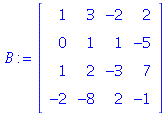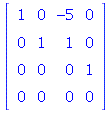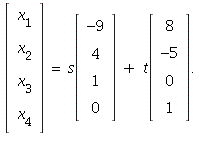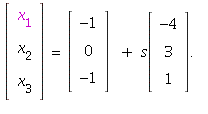| > |
MATH 244 -- Linear Algebra
Problem Set 2 Solutions
February 2, 2007
1.4/15 Form the augmented matrix [A|b] and perform the row
operation ![]() The result is the matrix:
The result is the matrix:
 This implies that the system is consistent
This implies that the system is consistent
only when ![]() This is not true for every vector b,
This is not true for every vector b,
of course. It is not true for instance if b =  Then
Then ![]()
The set of all b with ![]() is a line through the origin in
is a line through the origin in![]()
18. The two questions asked in this problem are two different
ways of asking the same thing. The span of the columns of B
is all of ![]() exactly when the system
exactly when the system ![]() has a solution for
has a solution for
all vectors ![]() (look at highlighted statement at the bottom
(look at highlighted statement at the bottom
of page 42 in the text) To answer the questions we proceed as
in 15 above (but omitting the ``extended column'' for simplicity):
| > |

| > |

| > |
Note that the last row does not contain a pivot entry. This means
that the system will be inconsistent for some choices of y .
In other words, there will be some equation that the components
of y must satisfy: ![]() constants)
constants)
in order for a solution of ![]() to exist. So the answers are:
to exist. So the answers are:
No, the columns of B do not span ![]()
No, the system ![]() does not have a solution for every y.
does not have a solution for every y.
26. ![]() since
since ![]()
31. If A is 3 x 2, then there can be at most pivot columns.
This means that the last row will not contain a pivot entry
So the rref of A will contain a zero row. As in 15, 18 above,
this means that the system ![]() will be inconsistent for
will be inconsistent for
some vectors b. The same reasoning shows that if A
is m x n with m > n, then there are at most n pivot columns,
which means some row cannot contain a pivot. Hence in
the rref of A, there is at least one zero row, and the system
will be inconsistent for some b.
32. The answer is: No. Let ![]() be the three vectors,
be the three vectors,
and let A be the 4 x 3 matrix with those columns. Since
4 > 3, the previous exercise shows that A x = y
will be inconsistent for some y. Hence by the highlighted
statement at the bottom of page 42 in the text, there will
be some vectors y that are not in the span of the columns
of A. The corresponding general statement is:
If we have n vectors in ![]() and m > n, then those vectors
and m > n, then those vectors
do not span ![]()
33. To get a unique solution of the system Ax = b
for some b, A must have three pivot entries, so
the rref is

1.5/6. The rref of the augmented matrix is
| > |
![table( [( 2, 2 ) = 4, ( 1, 4 ) = 0, ( 2, 1 ) = 1, ( 3, 4 ) = 0, ( 3, 3 ) = 9, ( 1, 3 ) = -5, ( 2, 4 ) = 0, ( 3, 1 ) = -3, ( 1, 2 ) = 3, ( 3, 2 ) = -7, ( 1, 1 ) = 1, ( 2, 3 ) = -8 ] )](images/PS2Sol_28.gif)
| > |
![table( [( 2, 2 ) = 1, ( 1, 4 ) = 0, ( 2, 1 ) = 0, ( 3, 4 ) = 0, ( 3, 3 ) = 0, ( 1, 3 ) = 4, ( 2, 4 ) = 0, ( 3, 1 ) = 0, ( 1, 2 ) = 0, ( 3, 2 ) = 0, ( 1, 1 ) = 1, ( 2, 3 ) = -3 ] )](images/PS2Sol_30.gif)
| > |
Hence the set of all solutions in parametric form is
 = `.`(s, Matrix(%id = 139596824))](images/PS2Sol_31.gif) (set the free variable
(set the free variable ![]()
7. Proceed as in 6:
| > |
![table( [( 2, 2 ) = 1, ( 1, 4 ) = 7, ( 2, 1 ) = 0, ( 2, 5 ) = 0, ( 1, 3 ) = -3, ( 2, 4 ) = 5, ( 1, 5 ) = 0, ( 1, 2 ) = 3, ( 1, 1 ) = 1, ( 2, 3 ) = -4 ] )](images/PS2Sol_34.gif)
| > |
![table( [( 2, 2 ) = 1, ( 1, 4 ) = -8, ( 2, 1 ) = 0, ( 2, 5 ) = 0, ( 1, 3 ) = 9, ( 2, 4 ) = 5, ( 1, 5 ) = 0, ( 1, 2 ) = 0, ( 1, 1 ) = 1, ( 2, 3 ) = -4 ] )](images/PS2Sol_36.gif)
| > |
Here ![]() are free variables. With
are free variables. With ![]()

16. The coefficient matrix here is the same as in problem 6. Hence
we can apply Theorem 6 from page 53 in the text and save some
work, provided we can find a particular solution p. By inspection
](images/PS2Sol_40.gif) is one solution of the system. Hence Theorem 6 says
is one solution of the system. Hence Theorem 6 says
the set of all solutions of the system will be
 This is the parametrization of
This is the parametrization of
a line in ![]() parallel to the line from problem 6.
parallel to the line from problem 6.
(Note: if you compute the solution by reducing the inhomogeneous
augmented matrix to echelon form, you will find a different particular
solution:
p = ](images/PS2Sol_43.gif)
Theorem 6 works with any particular solution, though. You just
get different parametrizations of the same line.
36. Any matrix whose rows dot with the given vector to give 0
is OK. One "random" example is

37. To find a suitable matrix A, just proceed as in 36.
One "random" matrix that works is

The set of solutions of A x = 0 is spanned by 
Start with a general vector b and form the augmented matrix:

Then if we replace row 2 by row 2 plus 3 times row 1 we get:

If ![]() then the system is inconsistent. Take
then the system is inconsistent. Take
b = ![]() for instance. We get an inconsistent system A x = b,
for instance. We get an inconsistent system A x = b,
so the set of solutions for this is the empty set. The empty
set is certainly not a line in ![]() parallel to the line through
parallel to the line through
 the origin (the set of solutions of A x = 0).
the origin (the set of solutions of A x = 0).
This does not contradict Theorem 6 because that result
includes the hypothesis that the inhomogeneous system
Ax = b is consistent. The theorem does not apply with our b.
38. No, there does not exist such a matrix. One way to see this:
when row operations are applied to the augmented matrix [A|y]
there must be at least one row of the form [0 0 0 | *] with * ≠ 0.
Now apply the same row operations to the augmented matrix
[A|z]. Then the entries in the 4th column in the zero row or rows
must now be zero since the system is consistent. But that means
that the system [A|z] has at least one free variable, so the
solution is not unique. (A second way to prove this is to
note that if [A|z] gives a unique solution for any z, then
A must have three pivot columns, and the same will then
be true for [A|y], since you would do the same row operations
on that system.)
1.7/1. Determining whether a given set of vectors is
linearly dependent is the same as determining whether
the homogeneous system [A | 0 ] (A = matrix whose
columns are the given vectors) has any free variables.
If so, then there is a way to make a linear combination
of the columns sum to zero with some coefficients
nonzero, and the set is dependent. If not, then there
there is no such linear combination, and the set is
independent.
| > |
![table( [( 2, 2 ) = 2, ( 2, 1 ) = 0, ( 3, 3 ) = -8, ( 1, 3 ) = 9, ( 3, 1 ) = 0, ( 1, 2 ) = 7, ( 3, 2 ) = -6, ( 1, 1 ) = 5, ( 2, 3 ) = 4 ] )](images/PS2Sol_54.gif)
| > |
![table( [( 2, 2 ) = 1, ( 2, 1 ) = 0, ( 3, 3 ) = 1, ( 1, 3 ) = 0, ( 3, 1 ) = 0, ( 1, 2 ) = 0, ( 3, 2 ) = 0, ( 1, 1 ) = 1, ( 2, 3 ) = 0 ] )](images/PS2Sol_56.gif)
| > |
No free variables, so the vectors are linearly independent.
6.
| > |
![table( [( 4, 2 ) = 4, ( 2, 2 ) = -1, ( 4, 1 ) = 5, ( 2, 1 ) = 0, ( 3, 3 ) = 3, ( 1, 3 ) = 0, ( 3, 1 ) = 1, ( 1, 2 ) = -3, ( 4, 3 ) = 6, ( 3, 2 ) = 0, ( 1, 1 ) = -4, ( 2, 3 ) = 4 ] )](images/PS2Sol_58.gif)
| > |
![table( [( 4, 2 ) = 0, ( 2, 2 ) = 1, ( 4, 1 ) = 0, ( 2, 1 ) = 0, ( 3, 3 ) = 1, ( 1, 3 ) = 0, ( 3, 1 ) = 0, ( 1, 2 ) = 0, ( 4, 3 ) = 0, ( 3, 2 ) = 0, ( 1, 1 ) = 1, ( 2, 3 ) = 0 ] )](images/PS2Sol_60.gif)
| > |
No free variables, so linearly independent.
9. If you are observant, you can answer this one with
no calculations whatsoever!
a) The span W of ![]() is a line in
is a line in ![]() because
because
![]() The vector
The vector ![]() cannot be on that line
cannot be on that line
(whatever h happens to be) because ![]() is not a scalar
is not a scalar
multiple of ![]() (the first two components are "wrong":
(the first two components are "wrong":
-7 ≠(-3)(5)) So: no h -- ![]() is never in W.
is never in W.
b) The set ![]() is linearly dependent for
is linearly dependent for
all h ∈ ℝ because of the equation ![]()
32. ](images/PS2Sol_70.gif) is one nontrivial solution (any scalar multiple
is one nontrivial solution (any scalar multiple
of this vector is another).
General Fact: Any set of vectors containing a linearly
dependent subset is linearly dependent.
34. This is true because we can make the linear dependence
relation
![]()
(Note the coefficient of ![]() so this implies linear dependence.
so this implies linear dependence.
36. This is false because there could be some other
dependence between the vectors ![]() that does not
that does not
involve ![]()
set ![]() by problem 34.)
by problem 34.)
38. This is true. Here is a proof. Consider any equation
![]() We can add a term with a zero
We can add a term with a zero
coefficient on the left without changing anything:
![]()
But now we are assuming that the set of 4 vectors is linearly
independent. That means that in this linear combination
that adds up to the zero vector, all the coefficients must
be zero: ![]() That shows that
That shows that ![]()
satisfies the definition of linear independence.
General Fact: Any subset of a linearly independent set is
linearly independent.
(The general proof follows exactly the same reasoning as
for this special case.)